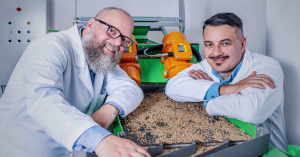“The biggest challenge is just starting the discussion about digitalization,” says Marius Pasca. He’s the co-founder and CEO of AgroCity, a software startup that helps farms gather and manage their data. The team has been developing and testing their digital solution since 2020. They are working with 5 medium and big farms in Romania to collect information from vehicles and sensors. The aim is to reduce their costs in the long term and to increase control, productivity, and profitability from production.
The AgroCity startup was developed because the founders needed this solution for their use when they took over the family farm, as well as their client’s: “One of my biggest problems was having better control at my farm. By control, I mean knowing exactly how much input I was using at the farm and how much output I was generating per hectare. Now, I can even access all this information from my smartphone,” shared one of the farmers using their technology.
AgroCity is part of a very competitive niche in Romania, as well as in the whole SEE region. Technology offers intelligent solutions to the modern challenges landowners are facing and is really the key to the potential growth of the agriculture industry.
This involves software monitoring with the help of data, acquired from the fields. Drones or different sensors can help raise crop productivity. It can also mean using new tools for farming. Natural fertilizers can improve the quality of the food and grow the yield of the farm.
The Big Picture: Romania is an important member of the European agricultural market, according to European Union’s statistics. Romania owns around 30% of the total number of agricultural holdings in the EU. The average size of a farm is about 3.6ha/holding, which is small compared to the European average of 16.6ha/holding. But The Union has granted the country access to €20B funds to develop this sector between 2021-2027.
The investor’s perspective: “Agritech is one of the main sectors of development in Romania in the next few years and there is plenty of space to work on digitalization there. Romania could feed over 80 million people with its agriculture, yet it is underdeveloped,” says Matei Dumitrescu, senior partner at ROCA X, a Romanian investment fund targeting disruptive startups.
Matei Dumitrescu is a pioneer of agritech in Romania, turned investor. He says that the vertical will continue to grow and ROCA X is looking forward to seeing initiatives related to autonomous machinery, sensors, satellite monitoring solutions, intelligent irrigation, to name a few.
“We have plenty of agritech startups from Romania in our pipeline and we are currently assessing the best ones to invest in as we know the market potential is great and that the technology-driven business is the key in this sector. ROCA Investments is interested in RDF, a venture that evolved into a digital business, implementing ERP systems for managing their activities and using IT equipment to be able to use real-time business information,” concluded Matei.

What challenges startups are facing: In Romania, small farm holdings can be a challenge for tech startup initiatives. Internet connectivity, time, funds, a limited and aging workforce, and an effort to train in specialized farming are factors that are holding back the digitalization of this sector.
“There are still some farmers who don’t understand what the benefits are for them until they see the first demo and then they realize how technology can increase their productivity,” says Marius Pasca.
Another startup that is active in this field is StartAgro. They have been developing smart solar greenhouses. They want to sustain regional development, encourage repatriation, and rebuild local, sustainable, communities. The project has been working on both family solar houses and commercial ones for a year now. These products can be kept all year round without using gas for heating or power for ventilating.
“We build isolated greenhouses with geothermal and solar energy, so we need a lot of technology to make it work. The main objection we have received so far is the high initial investment cost. We manage to reduce monthly operations costs by 5X and we use renewable energy during the summer,” says Sebastian Mindroiu, founding partner and architect of StartAgro.
He believes the company’s impact to be high in countries with colder winters. During winter, traditional greenhouses come with high costs, which are not sustainable. Their solution proposes a more economic growth environment in the long term. “We can move production locally, reducing transportation and refrigeration costs,” concluded Sebastian.
Agriculture market trends in Europe
The pandemic has disrupted all global markets, including the agri-food sector. The EIT Food, Europe’s leading food innovation initiative, presents a few different scenarios for the future.
- Consumers: A tech-oriented public will want local produce with more nutritional value. The client likes eating out and is aware of developing sustainable and less pollutant buying practices. Customers will look for more online delivery opportunities that ask for fast digitalization.
- Farmers: Taking the time to adapt and use technology to lower the environmental impact can shorten the distance between farmers and consumers. Agritech could offer a connection between clients and farmers, but also farmers and the ecosystem.
- The market: Тhe economy might have the opportunity to scale through increased regional cooperation. This might need self-sufficiency within the country or the region and extra investments in the transport infrastructure. Changes may lead to fast production, rising food prices due to the economic growth, larger players replacing smaller ones, and the employment share might drop as processes will be digitized.
UPDATE
On the 21st of May, Matei Dumitrescu said “Romania could feed over 80 billion people with its agriculture, yet it is underdeveloped,” but on the 24th of May he changed his quote to “80 million people”.







